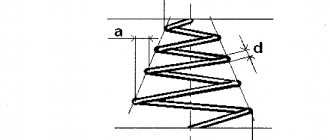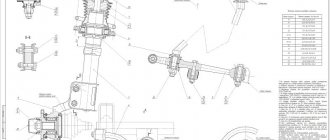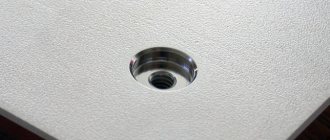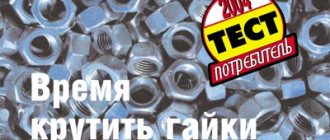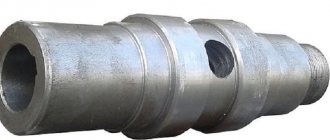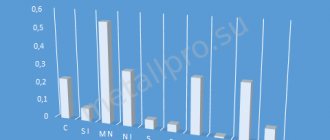4.3 Marking
4.3.1 Springs are marked on tags by stamping, engraving or waterproof paint. The tag is attached to the spring or packaging area. For springs made of wire with a diameter of more than 5 mm, it is allowed to apply electrographic markings on one of the support turns.
4.3.2 Marking includes the following information:
— trademark of the manufacturer;
— month and year of issue;
— spring (batch) number;
— drawing number or symbol of the spring;
— by agreement between the customer and the manufacturer, other necessary information can be included in the marking.
Helical coil springs compression and extension
Designer's reference
useful site for mechanical engineer
DIRECTORY
- VOLUME1
- General technical information
- Materials
- Surface roughness
- Tolerances and landings
- Structural elements
- Fasteners
- Standard and normalized parts and assemblies
- Protective and protective-decorative coatings of metals
- TOM2
- Axles and shafts
- Bearings
- Couplings
- Gear and worm gears
- Chain transmissions
- Belt drives
- Helical gears and ratchet gears
- Ball Screws
- Detachable connections
- VOLUME3
- Springs
- Sealing devices
MENU
- home
- Site Map
- Write to the author
- Vibration diagnostics of bearings 10/21/2013
Wheel bearing repair 10/21/2013
Replacing differential bearings 10/21/2013
- Sections
- Tolerances and landings
- Bearings
- Steel ropes
- Cast iron
- Channels
Note. The specified endurance does not apply to extension spring hooks.
2. Spring discharges (according to GOST 13764-86)
| Spring class | Spring discharge | Type of springs | Spring force at maximum deformation F3, N | Diameter of wire (rod) d, mm | Material | Hardness after heat treatment HRC | Maximum shear stress during torsion τ3, MPa | Hardening Requirement | Standard for the main parameters of spring coils | |
| steel grade | Workpiece standard | |||||||||
| 1 | 1 | Single-core compression and tension | 1,00-850 | 0,2-5,0 | According to GOST 1050-88 and GOST 1435-90 | Wire class 1 according to GOST 9389-75 | — | 0.3Rm | To increase cyclic resistance, shot hardening is recommended | GOST 13766-86 |
| 2 | 1,00-800 | Wire class 2 and 2A according to GOST 9389-75 | GOST 13767-86 | |||||||
| 22,4-800 | 1,2-5,0 | 51HFA according to GOST 14959-79 | Wire according to GOST 1071-81 | 0.32Rm | ||||||
| 3 | 140-6000 | 3,0-12,0 | 60С2А; 65S2VA; 70SZA according to GOST 14959-79 | Wire according to GOST 14963-78 | 47.5-53.5 | 560 | GOST 13768-86 | |||
| 1HFA according to GOST 14959-79 | 45.5-51.5 | |||||||||
| 4 | 2800-180000 | 14-70 | 60С2А; 65S2VA; 70SZA; 60С2; 60С2ХА; 60S2HFA; 51HFA according to GOST 14959-79 | Hot-rolled round steel according to GOST 2590-88 | 44.0-51.5 | 480 | GOST 13769-86 | |||
| II | 1 | Single-core compression and tension | 1,50-1400 | 0,2 — 5,0 | According to GOST 1050-88 and GOST 1435-90 | Wire class 1 according to GOST 9389-75 | — | 0,5 Rm | To increase cyclic resistance, shot hardening is recommended | GOST 13770-86. |
| 2 | 1,25-1250 | Wire classes 2 and 2A according to GOST 9389-75 | GOST 13771-86 | |||||||
| 37,5-1250 | 1,2 — 5,0 | 51HFA according to GOST 14959-79 | Wire according to GOST 1071-81 | 0,52 Rm | ||||||
| 3 | 236-10000 | 3,0 — 12,0 | 60С2А; 65S2VA according to GOST 14959-79 | Wire according to GOST 14963-78 | 47,5 — 53,5 | 960 | GOST 13772-86 | |||
| 65Gpo GOST 1050-88 | Wire according to GOST 2771-81 | |||||||||
| 51HFA according to GOST 14959-79 | Wire according to GOST 14963-78 | 45,5 — 51,5 | ||||||||
| 4 | 4500-280000 | 14-70 | 6OS2A; 60С2; 65S2VA; 70SZA; 51HFA; 65G; 60S2HFA; 60С2ХА according to GOST14959-79 | Hot-rolled round steel according to GOST 2590-88 | 44,0 — 51,5 | 800 | GOST 13773-86 | |||
| III | 1 | Three-core compression | 12,5-1000 | 0,3 — 2,8 | According to GOST 1050-88, GOST 1435-90 | Wire | — | 0,6 Rm | GOST 13774-86 | |
| 2 | Single strand compression | 315-14000 | 3,0 — 12,0 | 60С2А; 65S2VA; 70SZA according to GOST 14959-79 | Wire according to GOST 14963-78 | 54,5 — 58,0 | 1350 | Shot hardening is required | GOST 13775-86 | |
| 3 | 6000-20000 | 14-25 | 60С2А; 65S2VA; 70SZA according to GOST 14959-79 | Hot-rolled round steel according to GOST 2590-88 | 51,5 — 56,0 | 1050 | GOST 13776-86 | |||
Notes: 1. The maximum shear stress during torsion is given taking into account the curvature of the turns. 2. Rm -
tensile strength of spring materials
Increases in the difference τ3 ~ τ2 cause an increase in the endurance and durability of cyclic springs of all classes while simultaneously increasing the size of the units. A decrease in the differences τ3 - τ2 is accompanied by reverse changes in the service qualities and sizes of spaces in the mechanisms for placing springs. For class I springs, the design stresses and properties of the metal are regulated in such a way that when vmax /vk < 1, the specified endurance of the springs under the action of force F1 (spring force at preliminary deformation) of at least 0.2 F3 (spring force at maximum deformation) is ensured at all feasible locations and sizes of working sections on the force diagrams of the stress difference τ3 - τ2 and τ2 - τ1 (tangential stress during preliminary deformation). Class II cyclic springs with vmax /vk < 1, depending on the location and size of the working sections, can be subjected to conditions of both unlimited and limited endurance. Class III cyclic springs with all ratios vmax /vk and a relative inertial spring gap d of no more than 0.4 are characterized by limited endurance, since they are designed for extremely high tangential torsional stresses, to which, at vmax /vk > 1, contact stresses from the collision of the coils are added. All static springs that remain in a deformed state for a long time and are periodically loaded at a speed vmax / vk belong to class II. The introduced restrictions on design stresses and wire properties (see Table 2) ensure unlimited resistance of static springs with residual deformations of no more than 15% of the maximum deformation s3. The permissible residual deformations of static springs are regulated by the coordination of the spring forces at the working deformation s3 on the force diagrams, with an increase in the difference F3 - F2
helps reduce residual deformations. Technological means of regulating the endurance and resistance of springs are determined by the technical requirements documentation.
MATERIALS FOR SPRINGS
Carbon steel spring wire in accordance with GOST 9389-75. The standard applies to cold-drawn carbon steel wire used for the manufacture of cold-wound springs that are not quenched. The wire is manufactured: according to mechanical properties: grades A, B, C; classes 1, 2, 2A, 3 (recommendations for the use of spring wire depending on brands and classes are given in Table 3); by manufacturing accuracy: normal accuracy; increased precision P. Wire of classes 1, 2, 3 is manufactured with normal and increased accuracy, class 2A - with increased accuracy. The diameters of the wire and the weight of 1000 m of wire are indicated in the table. 4.
3. Recommendations for the use of spring wire according to GOST 9389-75
| Wire grade | Wire strength class | Conditions of use |
| A | 1 | For springs K no more than 0.10 |
| B | 1, 2, 2A, 3 | For springs K no more than 0.17 |
| IN | 1,2, 2A, 3 | For springs K no more than 0.30 |
Note. Relative strength run-up index K
calculated using the formula K= Δsв/sв, where Δsв is the run-up of tensile strength in a batch, N/mm2; sв is the minimum value of tensile strength in a class, N/mm2
4. Wire diameters and theoretical weight of 1000 m of wire
| Wire diameter, mm | Weight 1000 m, kg | Wire diameter, mm | Weight 1000 m, kg |
| 0,14 | 0,1208 | 1,50 | 13,87 |
| 0,15 | 0,1387 | 1,60 | 15,78 |
| 0,16 | 0,1578 | 1,70 | 17,82 |
| 0,18 | 0,1994 | 1,80 | 19,94 |
| 0,20 | 0,2465 | 1,90 | 22,26 |
| 0,22 | 0,298 | 2,00 | 24,65 |
| 0,25 | 0,385 | 2,10 | 27,19 |
| 0,28 | 0,484 | 2,20 | 29,83 |
| 0,30 | 0,555 | 2,30 | 32,58 |
| 0,32 | 0,631 | 2,50 | 38,54 |
| 0,36 | 0,80 | 2,80 | 48,36 |
| 0,40 | 0,99 | 3,00 | 55,50 |
| 0,45 | 1,25 | 3,20 | 63,11 |
| 0,50 | 1,54 | 3,40 | 71,28 |
| 0,56 | 1,93 | 3,50 | 75,52 |
| 0,60 | 2,22 | 3,60 | 79,9 |
| 0,63 | 2,45 | 4,00 | 98,7 |
| 0,70 | 3,02 | 4,20 | 108,7 |
| 0,75 | 3,47 | 4,50 | 124,8 |
| 0,80 | 3,95 | 5,00 | 154,2 |
| 0,85 | 4,45 | 5,60 | 193,3 |
| 0,90 | 4,99 | 6,00 | 221,9 |
| 1,00 | 6,17 | 6,30 | 244,4 |
| 1,10 | 7,46 | 6,50 | 260,5 |
| 1,20 | 8,88 | 6,70 | 276,8 |
| 1,30 | 10,42 | 7,00 | 302,1 |
| 1,40 | 12,08 | 7,50 | 346,8 |
| 8,00 | 394,6 |
The mechanical properties of the wire are given in table. 5. Examples of designations: Wire grade A, class 1, increased accuracy, diameter 1.20 mm:
Wire A-1-P-1, 20 GOST 9389-75
The same, brand B, class 3, normal accuracy, diameter 2.00 mm:
Wire B-3-2.00, GOST9389-75
Steel grade 65G. Increased tendency to form hardening cracks. They are used to reduce the cost of production for mass-produced products in cases where spring breakages do not cause disruption in the functioning of mechanism parts and replacing springs is not labor-intensive.
Steel grade 51HFA.
Increased heat resistance. Hardened to a hardness of no more than 53HRC. Due to its high elastic and viscous properties, it is the best material for class 1 springs. It is unsuitable for class 3 springs due to insufficient hardness.
Steel grades 60С2А, 60С2.
High elastic and viscous properties.
Increased tendency to graphitization and insufficient hardenability for sections d >
20 mm. Widely used for springs of classes 1 and 2. For springs of class 3 they are prescribed for vmax < 6 m/s.
Steel grade 65S2VA. High elastic properties and viscosity. Increased hardenability. Serves as the best material for class 3 springs. Used for vmax > 6 m/s.
Steel grade 60S2HFA. High hardenability, low tendency to grain growth and decarburization when heated (compared to 60C2A steel), increased toughness, heat resistance and cold resistance, good cyclic strength and relaxation resistance in a wide range of cyclic temperature changes. Preferred use in wire sections of 30 mm and above.
Steel grade 70SZA. Increased hardenability. Has a tendency to graphitize. Preferred use with wire diameters d
£20mm.
The substitute is steel 60S2N2A. Note.
The predominant practical use of springs made of 51KhFA steel is determined by the temperature range from - 180 to +250 °C, from 60S2KhFA steel from - 100 to +250 °C, from class 2A wire according to GOST 9389-75 from - 180 to +120 °C, from steels 65G, 70SZA, 60S2A, 65S2VA and from wire of class 1 according to GOST 9389-75 from - 60 to + 120 °C. In cases where springs are used at higher temperatures, it is recommended to take into account the temperature changes of the module.
Special steel alloy spring wire (according to GOST 14963-78)
. Designed for the manufacture of springs subjected to heat treatment (hardening and tempering) after winding.
The wire is divided: according to the manufacturing method and the quality of surface finishing into groups: with special surface finishing by removing the surface layer - A, B, C, D, E; without special surface finishing H; by manufacturing accuracy: normal accuracy; increased accuracy P; by purpose: for cold coil springs XN; for hot coil springs GN; according to mechanical properties, surface quality into classes: 1 - for springs for critical purposes; 2 - for general purpose springs.
Nominal wire diameters, mm: 0.5; 0.56; 0.60; 0.63; 0.71; 0.80; 0.90; 1.10; 1.20; 1.25; 1.30; 1.40; 1.50; 1.60; 1.80; 2.0; 2.20; 2.50; 2.80; 3.00; 3.20; 3.50; 3.80; 4.00; 4.20; 4.50; 4.80; 5.00; 5.50; 5.60; 6.00; 6.20; 6.30; 6.50; 7.00; 7.10; 7.50; 8.00; 8.50; 9.00; 9.50; 10.00; 11.00; 11.20; 11.50; 12.00; 12.50; 13.00; 14.00.
Wire of groups A, B, C, D should be made with a diameter of 1-14 mm, wire of groups E, H - with a diameter of 0.5-14.0 mm.
An example of the designation of wire made of steel grade 51HFA, with a special surface finish, polished, group A, increased accuracy, class 1 for cold coil springs, diameter 1.80 mm:
Wire 51ХFA-А-П-1-ХН-1.80 GOST 14963-78
Technical requirements. The wire must be made of steel grades 51KhFA, 60S2A, 65S2VA, 70SZA in accordance with GOST 14959-79. The tensile strength of wire for cold coil springs should be no more than 1029.5 MPa.
5. Mechanical properties of spring wire according to GOST 9389-75 as amended. 1990
| Wire diameter, mm | Tensile strength, N/mm2 | Range of temporary tensile strength in a batch, N/mm2, no more | Number of twists, not less | |||||||||||||
| Grade A | Brand B | Brand B | Brand A, B | Brand B | ||||||||||||
| Class 1 | Class 2, 2A | Class 3 | Class | Class | ||||||||||||
| 1 | 1, 2, 2A,3 | 1 | 2, 2A | 3 | 1 | 2 | 2A | 3 | 1 | 2 | 2A | 3 | ||||
| 0,20 | 2700-3040 | 2260-2700 | 1770-2260 | 300 | 300 | 340 | 440 | 490 | 30 | 30 | 32 | 30 | 30 | 30 | 32 | 30 |
| 0,22 | 2700-3040 | 2260-2700 | 1770-2260 | 300 | 300 | 340 | 440 | 490 | 29 | 29 | 32 | 29 | 29 | 29 | 32 | 29 |
| 0,25 | 2700-3040 | 2260-2700 | 1770-2260 | 300 | 300 | 340 | 440 | 490 | 27 | 27 | 32 | 27 | 27 | 27 | 32 | 27 |
| 0,28 | 2700-3040 | 2260-2700 | 1770-2260 | 290 | 290 | 340 | 440 | 490 | 26 | 26 | 31 | 26 | 26 | 26 | 31 | 26 |
| 0,30 | 2700-3040 | 2260-2700 | 1770-2260 | 280 | 280 | 340 | 440 | 490 | 23 | 23 | 31 | 23 | 23 | 23 | 31 | 23 |
| 0,32 | 2650-2990 | 2210-2650 | 1720-2210 | 270 | 280 | 340 | 440 | 490 | 22 | 22 | 30 | 22 | 22 | 22 | 30 | 22 |
| 0,36 | Designer's Handbook - Everything any designer needs! ©2008-2021 | |||||||||||||||
